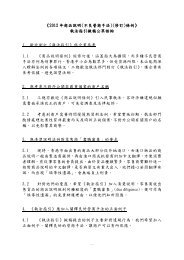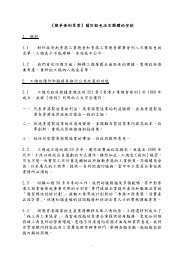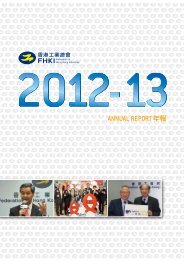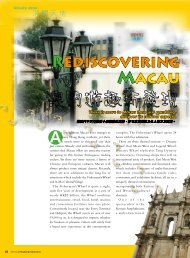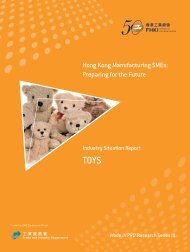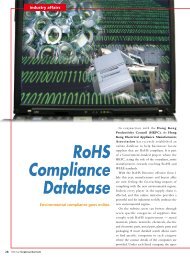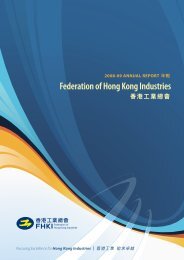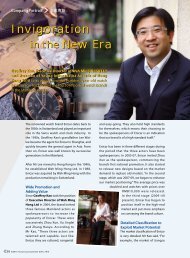Hong Kong Manufacturing SMEs: Preparing for the Future
Hong Kong Manufacturing SMEs: Preparing for the Future
Hong Kong Manufacturing SMEs: Preparing for the Future
- No tags were found...
You also want an ePaper? Increase the reach of your titles
YUMPU automatically turns print PDFs into web optimized ePapers that Google loves.
31Failure to DifferentiateMany <strong>Hong</strong> <strong>Kong</strong> <strong>SMEs</strong> have not identified aspecific niche and differentiated <strong>the</strong>mselves to<strong>the</strong> extent that customers view <strong>the</strong>m as havingsomething unique and valuable. The absence ofdifferentiation leaves a company open to pureprice competition and to customers constantlydemanding lower and lower prices regardlessof costs. The key to differentiation is to identifyspecific customer requirements and <strong>the</strong>n meetthose requirements better than <strong>the</strong> competitors.If successful, such differentiation usually leads toat least a limited amount of pricing power, whichprovides some insulation against difficult economictimes. Many <strong>Hong</strong> <strong>Kong</strong> companies have yet todevelop truly distinguishing capabilities. As a result,<strong>the</strong>y are vulnerable to competition from o<strong>the</strong>r <strong>Hong</strong><strong>Kong</strong> companies as well as those from <strong>the</strong> ChineseMainland.Limited Scope of ManagementMany <strong>Hong</strong> <strong>Kong</strong> <strong>SMEs</strong> have a limited scope ofmanagement in terms of numbers, geographicscope, activity scope, and market scope. <strong>Hong</strong><strong>Kong</strong> <strong>SMEs</strong> generally have one or a small numberof senior managers that are <strong>the</strong> driving <strong>for</strong>ces of <strong>the</strong>company. A small number of managers means that<strong>the</strong> companies suffer significantly when new rules,regulations, and administrative requirements comeinto effect. In geographic terms, many <strong>Hong</strong> <strong>Kong</strong><strong>SMEs</strong> appear to be able to manage within <strong>Hong</strong><strong>Kong</strong> and perhaps in certain cities in Guangdong,but have a hard time managing activities elsewhere.This limits <strong>the</strong>ir ability to react to rising costs andshifting policies, and limits <strong>the</strong>ir potential to takeadvantage of newly emerging manufacturinglocations elsewhere in China, elsewhere in EastAsia, or elsewhere in <strong>the</strong> world. In many cases,<strong>Hong</strong> <strong>Kong</strong> SME managers that have operated inGuangdong <strong>for</strong> many years still do not really knowGuangdong, <strong>the</strong> local officials, <strong>the</strong> local suppliers,and <strong>the</strong> local competitors nearly as well as newlyemerging Chinese counterparts. While this maynot have been an issue when <strong>the</strong>re were relativelyfew capable Mainland Chinese managers andcompanies, it is less and less <strong>the</strong> case.In terms of activity scope, many <strong>Hong</strong> <strong>Kong</strong>SME managers are com<strong>for</strong>table producing <strong>for</strong>OEM customers that provide <strong>the</strong> orders and <strong>the</strong>specifications, and <strong>the</strong>n distribute <strong>the</strong> products.Far fewer <strong>Hong</strong> <strong>Kong</strong> <strong>SMEs</strong> are com<strong>for</strong>tabledeveloping <strong>the</strong>ir own designs, getting <strong>the</strong>ir ownorders in overseas markets, and <strong>the</strong>n distributinginternationally. This of course limits <strong>the</strong> scope ofwhat <strong>the</strong>y can do in good times or bad. Finally, asrelatively few <strong>Hong</strong> <strong>Kong</strong> <strong>SMEs</strong> have engaged insignificant market development, <strong>the</strong>y are reliant ono<strong>the</strong>rs to carry out this process. This means thatmany <strong>SMEs</strong> are not in regular contact with endcustomers and <strong>the</strong>re<strong>for</strong>e have a more difficult timeanticipating or leading industry trends.Gaps in SuccessionMany <strong>Hong</strong> <strong>Kong</strong>’s manufacturing companieswere founded in <strong>the</strong> 1980s or earlier and rapidlyexpanded with <strong>the</strong> growth in South China in <strong>the</strong>1990s. In many cases, <strong>the</strong> founder or proprietor isnearing retirement age with no apparent successor.In some cases, <strong>the</strong>re are no children that can takeover. In o<strong>the</strong>r cases, <strong>the</strong> children are pursuing o<strong>the</strong>rinterests, or careers in industries that are consideredmore prestigious and less difficult, and do not wishto take over. Since <strong>the</strong> vast majority of <strong>Hong</strong> <strong>Kong</strong><strong>SMEs</strong> are family firms with members of <strong>the</strong> familyas managers, this creates a difficult situation. Withno obvious successors and with difficulty in sellinga company that has often been built around asingle individual, <strong>for</strong> many SME owners <strong>the</strong>re is noclear exit strategy. The risk is that o<strong>the</strong>rwise strongcompanies with good franchises may fall on hardtimes and cease to contribute to <strong>Hong</strong> <strong>Kong</strong> and toSouth China.




